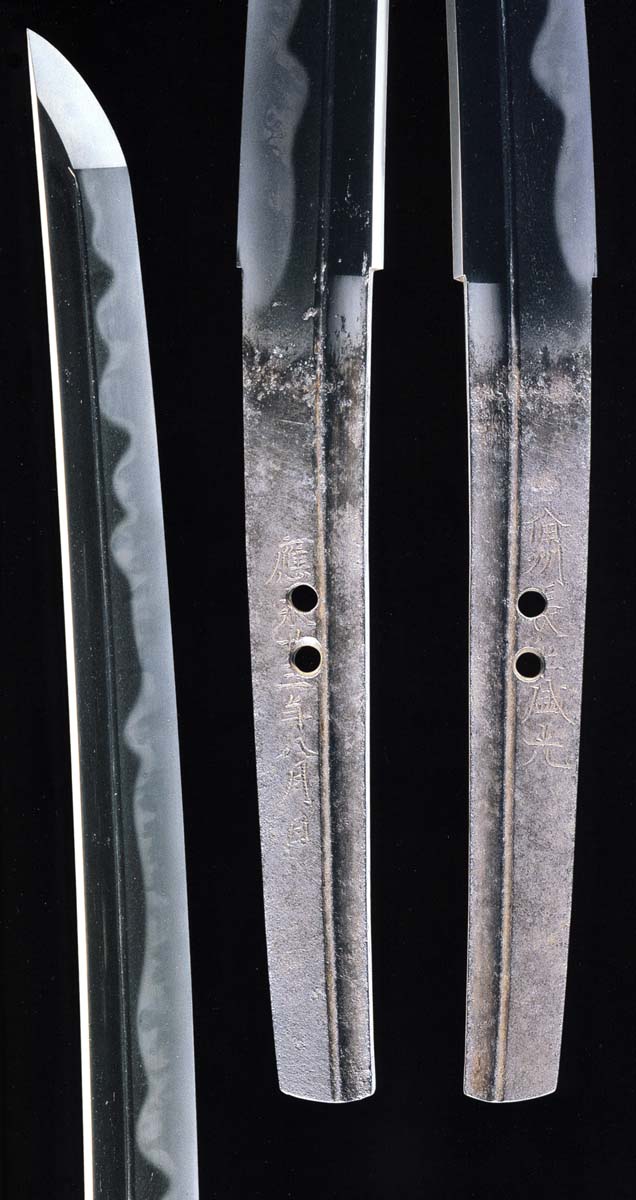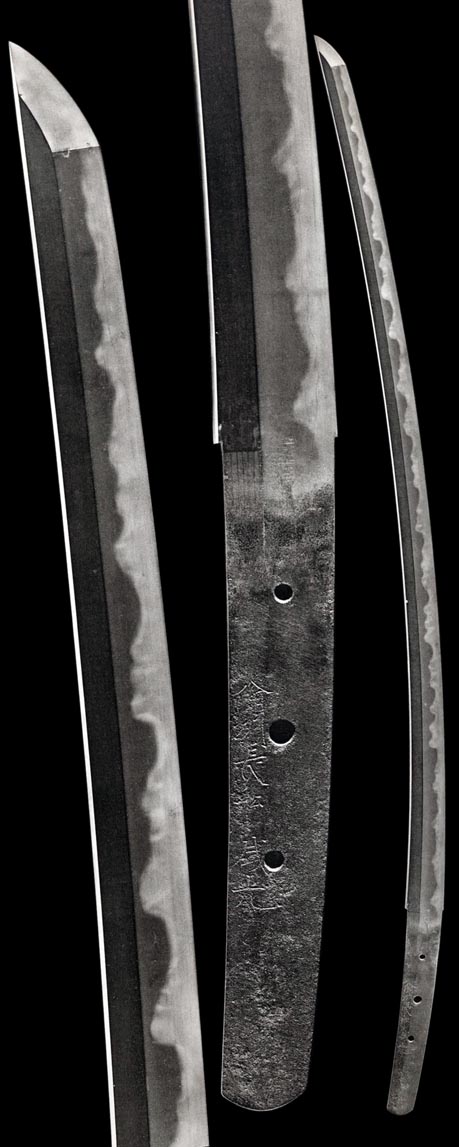| ©
Copyright Robert Cole 2015
- No copying or distributing - OEI BIZEN |
* The Three MITSUs *
MOROMITSU
MORIMITSU
YASUMITSU
|
* The Three MITSUs * |
| -MITSUTADA
-NAGAMITSU -KAGEMITSU -KANEMITSU -TOMOMITSU -MOROMITSU -OEI MORIMITSU O-EI 1394 |
OEI: A major marker in the long OSAFUNE master line. Graceful Kamakura Sugata returns. SUNNOBI-TSUKURI "Stretched" TANTO or short swords are seen. The O-EI is marked by the lively, exuberant HAMON patterns of KANEMITSU descendant, MORIMITSU, the new BIZEN star. His KOSHI-HIRAKI GUNOME-CHOJI MIDARE BA ignites the country. |
Technical: SUGATA - Some TACHI but mostly KOSHIZORI KATANA. Graceful tapering finds a small or medium BIZEN KISSAKI. The blades have a certain thickness when compared with KANEMITSU school. Note: O-EI shows a sudden rise in BO-HI. Wide and thin grooves abound. Deeply carved SU-KEN and BONJI abound. Note: 1 SHAKU 2 or so SUN, thick and noticeably narrow KO-WAKIZASHI, called SUNNOBI -TSUKURI appearing to be an altered NAMBOKUCHO DAMBIRA is peculiar to the O-EI and known as the OEI BIZEN O-TANTO.
_______________ KANEMITSU SODEN ____|____ TOMOMITSU (br: O-KANEMITSU) |_________________________ ____|____ ____|____ MOROMITSU MORIMITSU(1) _________________ |_________________________ KOZORI SHIGEYOSHI ____|____ ________________|____ ______________|____ MOROMITSU(2) SHURInoSUKE MORIMITSU(2) UEMONnoJO YASUMITSU(1) ____|____ ________________|____ ____________________ MORIMITSU(3) SAKYOnoSUKE YASUMITSU(2) IYESUKE and TSUNEIYE ____________________ SHINZAEMON SANEMITSU Note: O-EI is a time. OEI BIZEN is a school and style. |
|
OEI BIZEN OEI MORIMITSU The Three MITSUs _______________ KANEMITSU SODEN ___|___________ OEI BIZEN SODEN TOMOMITSU EN-BUN 1356 (br: O-KANEMITSU) "The Three MITSUs" |____________________ __________________________________ ___|_____ ___|_____ ___________|_____ MOROMITSU(1) MORIMITSU(1) EI-TOKU TADAMITSU | EI-TOKU 1381 SHI-TOKU 1384 __________________|_____ | GOROZAEMONnoJO TADAMITSU |__________________________________ _________________________ ___|_____ __________|___ | MOROMITSU(2) O-EI 1394 OMIYA MORIKAGE(2) SHI-TOKU 1384 | ___|_____ |__________ ________ | MOROMITSU(3) HO-TOKU 1449 __________|__ ____|____ ___|___ | ___|_____ OEI MOERIKAGE(3) HARUMITSU IYESUKE | MOROMITSU(4) MEI-O 1492 - See OEI MORIKAGE Group - | _________________________ __________________| _______________|_____ - brothers - ___|______ SHURINOSUKE MORIMITSU(2) O-EI 1394 YOSHIMITSU(1) O-EI 1394 _________|_____________ __________ ___________________ ___|___ ___|_____ ___|_____ ___|____ | MORIUJI MORIMITSU(3) MORISHIGE MORIMOTO(4) | O-EI 1394 - EI-KYO 1429 - ___________________| ____|___ KUNISUKE KA-KEI 1387 ____|____ KUNIMITSU(1) OEI period ____|____ KUNIMITSU(2) SHO-CHO 1428 Note: MOROMITSU son, MORIKAGE is second OMIYA stylist - see OEI MORIKAGE Group, OMIYA and KOZORI IYESUKE OEI BIZEN Roots: The SODEN TOMOMITSU EN-BUN (f: KAGEMITSU, br: KANEMITSU): Student of his elder brother and therefore considered a member of the SODEN. See KANEMITSU School TADAMITSU(4) EI-TOKU (t: TOMOMITSU): Possibly GOROZAEMON, or the father of GOROZAEMON, from TOMOMITSUs' KANEMITSU SODEN. The 5th TADAMITSU, IYEMORI son, JIROZAEMON, touches KOZORI before the line flows to SUE-BIZEN. ] See KANEMITSU School, KOZORI IYEMORI and SUE-BIZEN GOROZAEMON TADAMITSU O-EI: A prolific maker, this last of the SODEN line resides in the O-EI. MOKUME HADA. CHOJI BA. BISHU OSAFUNE GOROZAEMONnoJO TADAMITSU |
 Tokyo National Museum Oei Morimitsu Nagasa: 68cm Sori: 1.7cm Shinogi-tsukuri, Ihori-mune Tachi Sugata. Chu-Kissaki. Bo-hi RenBi. Saka Gunome Choji-Midare in his Koshi-Hiraki, Oei Hamon style. Strong, slightly altered Nakago. Signed: Bishu Osafune Morimitsu Oei NiJu Sannen Hachi Gatsu-Hi - 1416 |
OEI BIZEN - MORIMITSU The Three MITSUs The Three MITSUs MOROMITSU(1) EI-TOKU (f: TOMOMITSU): EI-TOKU 1381 to MEI-TOKU 1390. Brings KANEMITSU roots for the OEI masters.Father of OEI MORIMITSU. MOKUME HADA. NOKOBA and GUNOME-CHOJI MIDARE with ASHI. MIDARE-BOSHI to KO-MARU. MOROMITSU BISHU OSAFUNE MOROMITSU MOROMITSU(2) O-EI (f: MOROMITSU 1): from O-EI 20 to EI-KYO 1429. OEI style GUNOME-MIDARE BA undulates gently. BISHU OSAFUNE MOROMITSU MORIMITSU(1) SHI-TOKU (f: TOMOMITSU, br: MOROMITSU): Younger son of TOMOMITSU, MOROMITSU is the elder brother. Work from O-AN 1368 to the O-EI. MOKUME HADA. O-MIDARE BA. Said to have signed mostly two character MEI. MORIMITSU BISHU OSAFUNE MORIMITSU KUNISUKE KA-KEI (t: MORIMITSU): From BITCHU to the OEI. EI-TOKU 1381 to MEI-TOKU 1390. OEI smith, OEI style. BISHU OSAFUNE KUNISUKE GOROSABURO NYUDO KUNISUKE KUNIMITSU(1) OEI (t: KUNISUKE): MOKUME HADA. KOSHIHIRAKE GUNOME- MIDARE BA in the OEI style. BISHU OSAFUNE KUNIMITSU BIZENnoKUNI JUNIN KUNIMITSU KUNIMITSU(2): SHO-CHO: OEI stylist with his father. BISHU OSAFUNE KUNIMITSU |
 Oei Morimitsu |
MORIMITSU: - Strong SUGATA to the KISSAKI. - Rounded, almost billowing KOSHI-HIRAKI "Wide-troughed" GUNOME/CHOJI MIDARE BA - ASHI and YO YASUMITSU: - A comparative narrowing in the MONOUCHI - An evenly laid, somewhat simpler pattern with TOGARI - Fewer ASHI and YO, more TAMA and TOBI |
Oei Morimitsu Oei Morimitsu Nagasa: 2 Shaku 3 Sun 7 Bu (71.81cm) Sori: 9 Bu (2.58cm) Moto-haba: 1 Sun (3.03cm) Saki-haba: 6 Bu 4 Rin (1.94cm) Kissaki-naga: 9 Bu 6 Rin (2.91cm) Moto=kasane: 2 Bu 6 Rin (0.79cm) Saki-kasane: 1 Bu 8 Rin (0.55cm) Nakago: 5 Sun 6 Bu (16.97cm) Nakagozori: 7 Rin (0.21cm) Shinogi-tsukuri, Ihori-mune, deeply curved, Chu-Kissaki. Ko-Itame Hada has standing Utsuri. Togari heads push through O-Gunome Midare, Ko-Choji Ba and valleys in his Koshi-hirake Oei Hamon. Ko-Ashi and Yo define while Sunagashi runs. Midare-Komi Ko-Maru and Togari turn on Ura. Typical Bizen Nakago falls fat and even to Kurijiri. Signed Tachi-Mei: Bishu Osafune Morimitsu Oei Ju Ni-nen Hachi Gatsu Hi |
BUNKAZAI OEI MORIMITSU NAGASA: 2 SHAKU 5.1 SUN MOTO-HABA: 9.8 BU SORI: 1.1 SUN SAKI-HABA: 6 BU NAKAGO: 6.1 SUN
The long honored and long
prized. TACHI-OMOTE:BISHU
OSAFUNE MORIMITSU
|
OEI BIZEN - MORIMITSU School YOSHIMITSU(1) O-EI (br: MORIMITSU): YOSHI form: GA "Celebration." Another last of the SODEN, he is the father of KANSHO UEMONnoJO YOSHIMITSU. See SUE-BIZEN MOKUME. YAKIBA: NIOI GUNOME-CHOJI MIDARE BA. Signed small. BIZEN-no-KUNI OSAFUNE YOSHIMITSU BIZEN-no-KUNI OSAFUNE JU YOSHIMITSU MORIMITSU(3) EI-KYO (f: MORIMITSU 2): MOKUME. HAMON resembles his father's KOSHI-HIRAKI GUNOME-CHOJI MIDARE BA. BISHU OSAFUNE MORIMITSU MORIMITSU(4) MEI-O: MOKUME HADA. GUNOME-TOGARI BA. BISHU OSAFUNE MORIMITSU BISHU OSAFUNE JU MORIMITSU MORIMOTO(4) EI-KYO (t: MORIMITSU): MORI form: SHU "Protector." MOKUME. KOSHI-HIRAKI GUNOME-MIDARE HA. 5th MORIMOTO in KAN-SHO 1460. BISHU OSAFUNE MORIMOTO MORISHIGE EI-KYO (f: MORIMITSU): Held to be his father's choice. His name is followed into the SUE-BIZEN. MOKUME HADA. GUNOME-CHOJI BA with ASHI-IRI. MORISHIGE BISHU OSAFUNE MORISHIGE |
|